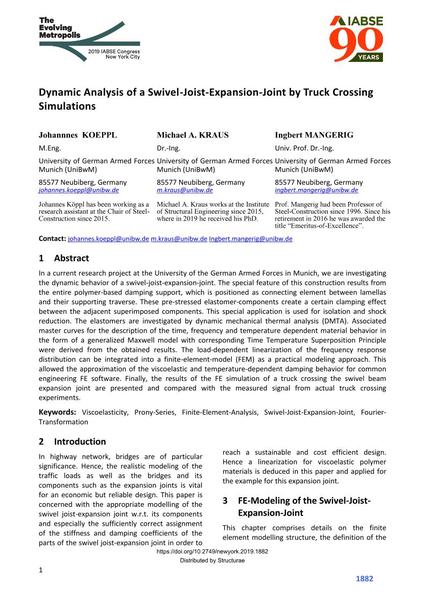Dynamic Analysis of a Swivel-Joist-Expansion-Joint by Truck Crossing Simulations

|
|
|||||||||||
Bibliographic Details
| Author(s): |
Johannes Köppl
(University of German Armed Forces Munich (UniBwM))
Michael A. Kraus (University of German Armed Forces Munich (UniBwM)) Ingbert Mangerig (University of German Armed Forces Munich (UniBwM)) |
||||
|---|---|---|---|---|---|
| Medium: | conference paper | ||||
| Language(s): | English | ||||
| Conference: | IABSE Congress: The Evolving Metropolis, New York, NY, USA, 4-6 September 2019 | ||||
| Published in: | The Evolving Metropolis | ||||
|
|||||
| Page(s): | 1882-1886 | ||||
| Total no. of pages: | 5 | ||||
| DOI: | 10.2749/newyork.2019.1882 | ||||
| Abstract: |
In a current research project at the University of the German Armed Forces in Munich, we are investigating the dynamic behavior of a swivel-joist-expansion-joint. The special feature of this construction results from the entire polymer-based damping support, which is positioned as connecting element between lamellas and their supporting traverse. These pre-stressed elastomer-components create a certain clamping effect between the adjacent superimposed components. This special application is used for isolation and shock reduction. The elastomers are investigated by dynamic mechanical thermal analysis (DMTA). Associated master curves for the description of the time, frequency and temperature dependent material behavior in the form of a generalized Maxwell model with corresponding Time Temperature Superposition Principle were derived from the obtained results. The load-dependent linearization of the frequency response distribution can be integrated into a finite-element-model (FEM) as a practical modeling approach. This allowed the approximation of the viscoelastic and temperature-dependent damping behavior for common engineering FE software. Finally, the results of the FE simulation of a truck crossing the swivel beam expansion joint are presented and compared with the measured signal from actual truck crossing experiments. |
||||
| Keywords: |
viscoelasticity Prony series finite element analysis swivel-joist expansion joint Fourier transformation
|
||||
